Oracle® Enterprise Manager Ops Center
Creating Public Networks
12c Release 2 (12.2.2.0.0)
E40773-04
December 2014
This guide provides an end-to-end example for how to use Oracle Enterprise Manager Ops Center.
Note:
This procedure is for Release 12.2.0.0.0 and Release 12.2.1.0.0.Introduction
Oracle Enterprise Manager Ops Center creates a dynamic environment that manages the life cycle of networks. When Oracle Enterprise Manager Ops Center has control of the resources of the underlying switching fabric, you can create new public networks in a network domain by defining specific network resources. These networks are available for assignment to the virtualization hosts and server pools that are associated with the network domain.
An Ethernet fabric can support many virtual LANs, identified by tags called VLAN IDs. In a similar way, an InfiniBand fabric has partitions and identifies them by partitions keys.
Networks are introduced into Oracle Enterprise Manager Ops Center in the followings ways:
-
By discovering existing network interfaces on hosts and servers. Oracle Enterprise Manager Ops Center acquires the subnet address and the VLAN IDs or partition keys of the virtual LAN carrying the network. You can change the attributes of the network, but not its subnet address and VLAN or partition.
-
By defining the network from the resources of its fabric. This is the result of the Define Network action.
-
By creating a network from the network domain. For a public network, use the Create Network action to specify the IP addresses. For a private network, which operates only within its network domain, use the Create Private Network action so that Oracle Enterprise Manager Ops Center can allocate IP addresses from the network domain's private IP address space.
The Oracle Enterprise Manager Ops Center software always has a default network domain and all public networks are members of it. A new public network becomes a member of the default network domain and a member of any selected user-defined network domain.
This document describes how to create a new public network in a user-defined network domain.
See Related Articles and Resources for links to related information and articles.
What You Will Need
-
A fully-managed fabric. To see the available fabrics, expand Networks in the Assets pane and select Fabrics. For each fabric, the Dashboard in the center pane includes a Management Capability field.
-
A user-defined network domain, as described in Creating and Managing a Network Domain in the Deploy How To library at http://docs.oracle.com/cd/E40871_01/nav/deployhowto.htm
-
The Net Admin role
Hardware and Software Configuration
In its role as the interface between a physical network switch and the virtual networks, the network domain manages VLAN IDs, partition keys, and IP addresses. The physical connection must also be in place; each physical server that supports virtualization hosts must have a physical connection to a fabric. During the procedure, you will specify a network interface.
Create a New Network
-
In the Standard Views, select Networks.
-
Select a user-defined network domain.

Description of the illustration creatnw_asset_select.png
-
Select Create Network in the Action pane.
-
Specify the IP address space for the new network.

Description of the illustration creatnw_step1b.png
-
Select the fabric to support the new network. In this example, a fabric named Test has been selected. Because this is an Ethernet fabric, VLAN IDs define the network.
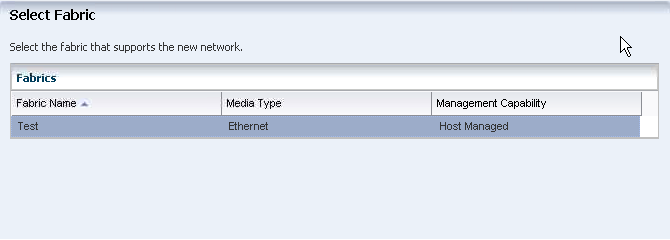
Description of the illustration creatnw_step2a.png
-
Assign the new network to an asset. If you choose, you can skip this step and assign the network later.
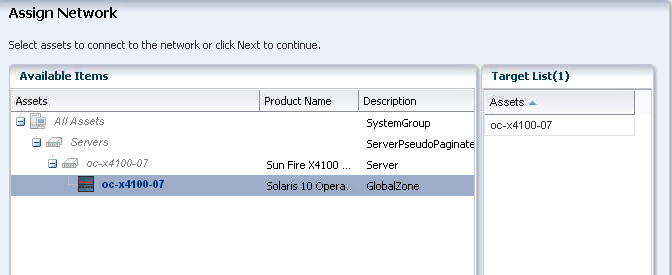
Description of the illustration creatnw_step3_selectgz.png
-
Specify the number of connections that an asset can make to the new network. Accept the default number of 1 or, if you know that the server that supports the virtualization host has multiple physical connections, you can increase the number to match.
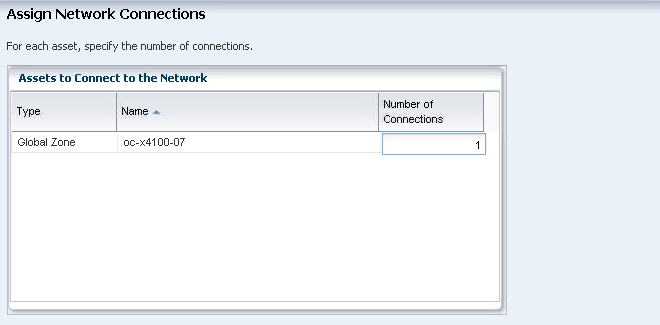
Description of the illustration creatnw_step4a.png
-
Specify how the new network connects to an asset by identifying the NIC and the IP address. In this example, the new network will connect to the global zone through the e1000g0 NIC.
-
In the NIC drop-down list, select NIC, e1000g0.
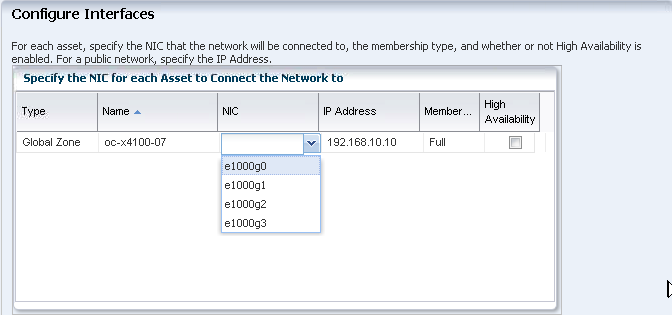
Description of the illustration creatnw_step5b_nic.png
-
Accept the default IP address and membership.
-
Click Next.
-
-
You have the option of assigning the new network to one or more Proxy Controllers.
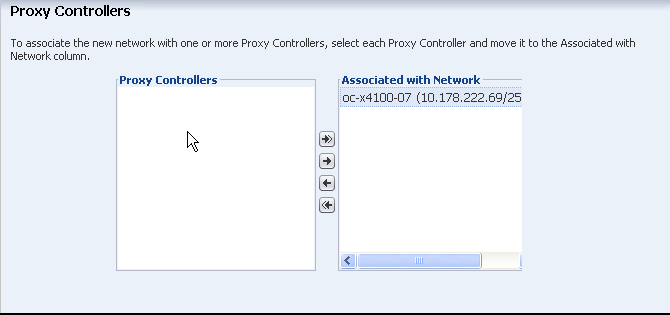
Description of the illustration creatnw_step6a.png
-
Review and click Finish.
The new network is now in the user-defined network domain.
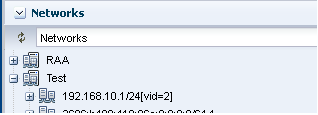
Description of the illustration creatnw_final.png
What's Next?
The network can be assigned to a virtualization host or server pool that is associated with network domain. To associate the user-defined network domain with a server pool, see Creating and Managing a Network Domain in the Deploy How To library at http://docs.oracle.com/cd/E40871_01/nav/deployhowto.htm.
Related Articles and Resources
The following chapters in the Oracle Enterprise Manager Ops Center Feature Reference Guide contain more information:
-
Networks
-
Server Pools
Documentation Accessibility
For information about Oracle's commitment to accessibility, visit the Oracle Accessibility Program website at http://www.oracle.com/pls/topic/lookup?ctx=acc&id=docacc.
Oracle customers that have purchased support have access to electronic support through My Oracle Support. For information, visit http://www.oracle.com/pls/topic/lookup?ctx=acc&id=info or visit http://www.oracle.com/pls/topic/lookup?ctx=acc&id=trs if you are hearing impaired.
Oracle Enterprise Manager Ops Center Creating Public Networks, 12c Release 2 (12.2.2.0.0)
E40773-04
Copyright © 2007, 2014, Oracle and/or its affiliates. All rights reserved.
This software and related documentation are provided under a license agreement containing restrictions on use and disclosure and are protected by intellectual property laws. Except as expressly permitted in your license agreement or allowed by law, you may not use, copy, reproduce, translate, broadcast, modify, license, transmit, distribute, exhibit, perform, publish, or display any part, in any form, or by any means. Reverse engineering, disassembly, or decompilation of this software, unless required by law for interoperability, is prohibited.
The information contained herein is subject to change without notice and is not warranted to be error-free. If you find any errors, please report them to us in writing.
If this is software or related documentation that is delivered to the U.S. Government or anyone licensing it on behalf of the U.S. Government, then the following notice is applicable:
U.S. GOVERNMENT END USERS: Oracle programs, including any operating system, integrated software, any programs installed on the hardware, and/or documentation, delivered to U.S. Government end users are "commercial computer software" pursuant to the applicable Federal Acquisition Regulation and agency-specific supplemental regulations. As such, use, duplication, disclosure, modification, and adaptation of the programs, including any operating system, integrated software, any programs installed on the hardware, and/or documentation, shall be subject to license terms and license restrictions applicable to the programs. No other rights are granted to the U.S. Government.
This software or hardware is developed for general use in a variety of information management applications. It is not developed or intended for use in any inherently dangerous applications, including applications that may create a risk of personal injury. If you use this software or hardware in dangerous applications, then you shall be responsible to take all appropriate fail-safe, backup, redundancy, and other measures to ensure its safe use. Oracle Corporation and its affiliates disclaim any liability for any damages caused by use of this software or hardware in dangerous applications.
Oracle and Java are registered trademarks of Oracle and/or its affiliates. Other names may be trademarks of their respective owners.
Intel and Intel Xeon are trademarks or registered trademarks of Intel Corporation. All SPARC trademarks are used under license and are trademarks or registered trademarks of SPARC International, Inc. AMD, Opteron, the AMD logo, and the AMD Opteron logo are trademarks or registered trademarks of Advanced Micro Devices. UNIX is a registered trademark of The Open Group.
This software or hardware and documentation may provide access to or information about content, products, and services from third parties. Oracle Corporation and its affiliates are not responsible for and expressly disclaim all warranties of any kind with respect to third-party content, products, and services unless otherwise set forth in an applicable agreement between you and Oracle. Oracle Corporation and its affiliates will not be responsible for any loss, costs, or damages incurred due to your access to or use of third-party content, products, or services, except as set forth in an applicable agreement between you and Oracle.